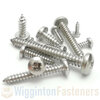We have a 70's house, the walls are solid but the internal block work is terrible. I've struggled getting decent fixings into the walls due to the walls being very crumbly.
I had some of these screws supplied with Fischer UX 8 plugs for a piece of furniture to be installed. These screws & plugs gave such a strong fixing every time. I'd love to be able to buy these screws from somewhere, however I've tried the usual suspects and can't find anything similar. Can any ID what type of screw this is and where to buy? I've been able to buy the plugs so it's just the screws I need.
I had some of these screws supplied with Fischer UX 8 plugs for a piece of furniture to be installed. These screws & plugs gave such a strong fixing every time. I'd love to be able to buy these screws from somewhere, however I've tried the usual suspects and can't find anything similar. Can any ID what type of screw this is and where to buy? I've been able to buy the plugs so it's just the screws I need.






